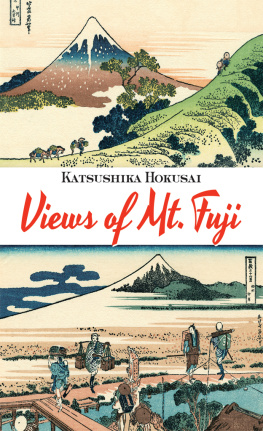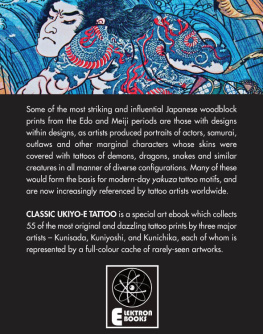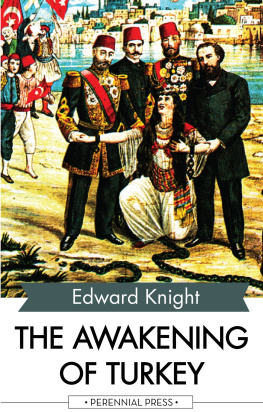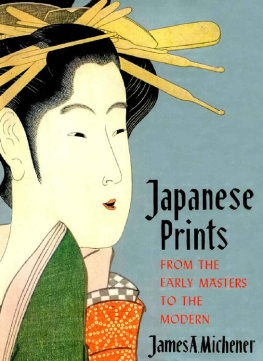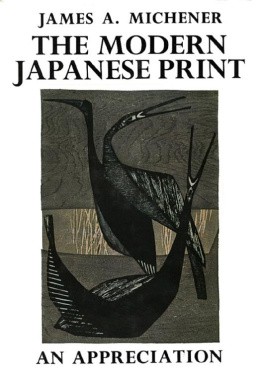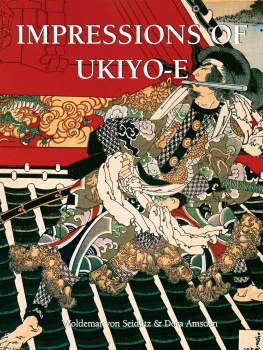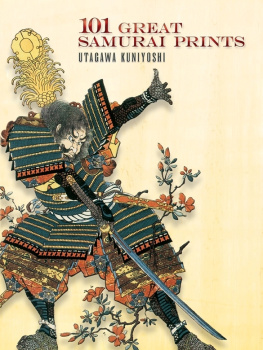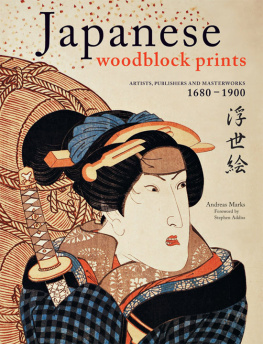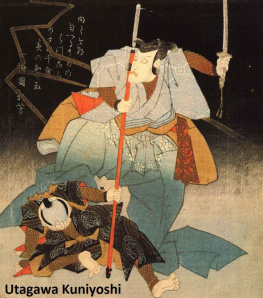Frederick Harris - Ukiyo-E: The Art of the Japanese Print
Here you can read online Frederick Harris - Ukiyo-E: The Art of the Japanese Print full text of the book (entire story) in english for free. Download pdf and epub, get meaning, cover and reviews about this ebook. year: 2012, publisher: Tuttle Publishing, genre: Romance novel. Description of the work, (preface) as well as reviews are available. Best literature library LitArk.com created for fans of good reading and offers a wide selection of genres:
Romance novel
Science fiction
Adventure
Detective
Science
History
Home and family
Prose
Art
Politics
Computer
Non-fiction
Religion
Business
Children
Humor
Choose a favorite category and find really read worthwhile books. Enjoy immersion in the world of imagination, feel the emotions of the characters or learn something new for yourself, make an fascinating discovery.
- Book:Ukiyo-E: The Art of the Japanese Print
- Author:
- Publisher:Tuttle Publishing
- Genre:
- Year:2012
- Rating:5 / 5
- Favourites:Add to favourites
- Your mark:
- 100
- 1
- 2
- 3
- 4
- 5
Ukiyo-E: The Art of the Japanese Print: summary, description and annotation
We offer to read an annotation, description, summary or preface (depends on what the author of the book "Ukiyo-E: The Art of the Japanese Print" wrote himself). If you haven't found the necessary information about the book — write in the comments, we will try to find it.
Ukiyo-E: The Art of the Japanese Print — read online for free the complete book (whole text) full work
Below is the text of the book, divided by pages. System saving the place of the last page read, allows you to conveniently read the book "Ukiyo-E: The Art of the Japanese Print" online for free, without having to search again every time where you left off. Put a bookmark, and you can go to the page where you finished reading at any time.
Font size:
Interval:
Bookmark:
Acknowledgments
In initial discussions with the publisher Eric Oey regarding the compilation of this book, he expressed concern over my inability to use a computer. I was not at all worried. I told him that Tolstoy had written War and Peace with a quill and I, at least, was in the possession of fountain pens. I also knew that there were people who would be able to help me produce the necessary computer disks from my handwritten manuscript.
My first assistant was Ms Nguyen Thi Diu in Hanoi, who has given me unstinting support throughout this whole project. Ms Michiko Yano, who took over from her, not only typed the text for me but also corrected any mistakes in my translation and interpretation of the Japanese script on the prints. Finally, there was the enormous assistance of Ms Kayoko Shimokawa, who organized the compilation of the illustrations required for the text and also managed me when I became confused over the sheer volume of illustrations we had to assemble for the book. I am most grateful for the wonderful assistance of these three women.
I also owe special thanks to David and Ken Caplan, father and son owners of Mita Arts Gallery, one of the worlds leading dealers of Japanese woodblock prints. This book would never have come to fruition without their support. Their knowledge of prints and their willingness to loan me items from their collection to illustrate this book are very much appreciated. Ken Caplan answered my numerous questions almost daily and always with a smile.
I am also grateful to the Adachi Institute of Woodblock Prints who allowed me access to their reprints of ukiyo-e masterpieces and also provided the photographs of master woodblock craftsmen at work.
It was most fortunate that I was able to locate an original Darani Sutra in the collection of Mr Akira Yagi, who allowed it to be photographed and was most helpful in answering my questions. My old friend Mr Ryo Kami assisted me in photographing the scroll, as well as the original Kuniyoshi block from my collection.
A special thanks goes to Mr Masaki Kasuya, my colleague, who took time off from his busy schedule to photograph the numerous pages from the illustrated books ( e-hon ) in my personal collection.
The Hokusai Manga was loaned to me for photography purposes by Mr Hara Shobo, an established ukiyo-e dealer in Jinbo-cho, Tokyo, to whom I am also very grateful.
Finally, I owe a great deal of thanks to Mrs Noor Azlina Yunus who was not only my editor but advised me in putting this text into readable form.
If I have left anyone out, my sincere apologies. This book has been a great adventure in learning.

Bibliography
Baird, Merrily, Symbols of Japan: Thematic Motifs in Art and Design , New York: Rizzoli International Publications, 2001.
Binyon, Lawrence and Sexton, J. J. OBrien, Japanese Colour Prints , London: Faber and Faber, 1960; first published 1923.
Brown, Louise Norton, Block Printing and Book Illustration in Japan , London: George Routledge and Sons, 1924.
The Cambridge History of Japan , 6 vols, Cambridge: Cambridge University Press, 198993.
Carpenter, John T. (ed.), Hokusai and His Age , Leiden: Hotei Publishing, 2005.
______, Reading Surimono: The Interplay of Text and Image in Japanese Prints, With a Catalogue of the Marino Lusy Collection , Leiden: Hotei Publishing, 2008.
Chibbett, David, The History of Japanese Printing and Book Illustration , Tokyo: Kodansha International, 1977.
Clark, Timothy, Kuniyoshi, London: Royal Academy Publications, 2009.
Evans, Tom and Evans, Mary Ann, Shunga: The Art of Love in Japan , 2nd edn, London: Paddington Press, 1975; first published 1949.
Gerstle, C. Andrew, with Timothy Clark and Akiko Yano, Kabuki Heroes on the Osaka Stage 17801830 , London: British Museum Press, 2005.
Hillier, Jack, The Art of the Japanese Book , 2 vols, London: Sothebys Publications, 1987.
______, Hokusai: Paintings, Drawings and Woodcuts , London: Phaidon Publishers, 1955.
______, The Japanese Picture Book: A Selection from the Ravicz Collection , New York: Harry N. Abrams, 1991.
Holloway, Owen E., Graphic Art of Japan: The Classical School , Tokyo: Charles E. Tuttle, 1971; first published London: Alec Tiranti, 1957.
Keyes, Roger S., Ehon: The Artist and the Book in Japan , New York: New York Public Library and University of Washington Press, 2006.
______, Surimono: Privately Published Japanese Prints in the Spencer Museum of Art , New York: Kodansha International, 1984.
Klompmakers, Inge, Japanese Erotic Prints: Shunga by Harunobu and Koryusai, Leiden: Hotei Publishing, 2008.
Merritt, Helen and Yamada, Nanako, Guide to Modern Japanese Wood-block Prints 19001975 , Honolulu: University of Hawaii Press, 1992.
Michener, James A., The Hokusai Sketch-Books: Selections from the Manga , Tokyo and Rutland, Vermont: Charles E. Tuttle, 1958.
______ (with notes on the prints by Richard Lane), Japanese Prints: From the Early Masters to the Modern , Tokyo and Rutland, Vermont: Charles E. Tuttle, 1959.
Narazaki, Muneshige (English adaptation by C. H. Mitchell), The Japanese Print: Its Evolution and Essence , Tokyo: Kodansha International, 1966.
Roberts, Laurance P., A Dictionary of Japanese Artists: Painting, Sculpture, Ceramics, Prints, Lacquer , Tokyo: Weatherhill, 1976.
Salter, Rebecca, Japanese Woodblock Printing , London: A. C. Black and Honolulu: University of Hawaii Press, 2001.
Stephens, Amy Reigle (ed.), The New Wave: Twentieth Century Japanese Prints from the Robert O. Muller Collection , London: Bamboo Publishing, 1993.
Strange, Edward F., The Color-Prints of Hiroshige , London: Cassell and Company, 1925.
______, Japanese Color Prints , London: Wyman and Sons, 1908.
Uhlenbeck, Chris and Winkel, Margarita (eds), Japanese Erotic Fantasies: Sexual Imagery of the Edo Period , Leiden: Hotei Publishing, 2005.
CHAPTER ONE
Historical Background
T he history of the Japanese print follows two main trajectories. The first is the use of woodblock cutting in the eighth century as a means of producing reproductions of religious texts. The second is the development, over a number of phases, of the wood-cut technique as an illustration form. The earliest bold black ink printed pictures ( sumizuri-e ) that developed around 1600, gave way in the period 172040 to delicately hand-colored pink pictures ( beni-e ) tinted with a pink ink produced from the safflower, and two-color hand-colored prints ( tan-e ) using red and green pigments. This led to the evolution, around 1745, of the earliest mass-produced color woodblock prints, literally pink printed pictures ( benizuri-e ), which initially used two color blocks, a light green and a light red, in imitation of the hand-colored tan-e color scheme. A third color, yellow, was added in the 1750s. The final stage of development, the mass-produced multicolored block-printed brocade pictures ( nishiki-e ) that we generally associate with this art form today, began in the mid-1760s in Edo (the former name for Tokyo).
In the available literature on ancient Buddhist prints, there is no consensus as to when woodblock prints were first made in Japan although most sources agree that the purpose of the print was to spread the knowledge of Buddhism in Japan. Woodblock-printed books from Chinese temples, carried by travelers, were seen in Japan as early as the eighth century. There is also agreement that the technique, and subsequent expertise of the craft, originated in China and was probably brought to Japan via Korea.
Font size:
Interval:
Bookmark:
Similar books «Ukiyo-E: The Art of the Japanese Print»
Look at similar books to Ukiyo-E: The Art of the Japanese Print. We have selected literature similar in name and meaning in the hope of providing readers with more options to find new, interesting, not yet read works.
Discussion, reviews of the book Ukiyo-E: The Art of the Japanese Print and just readers' own opinions. Leave your comments, write what you think about the work, its meaning or the main characters. Specify what exactly you liked and what you didn't like, and why you think so.


